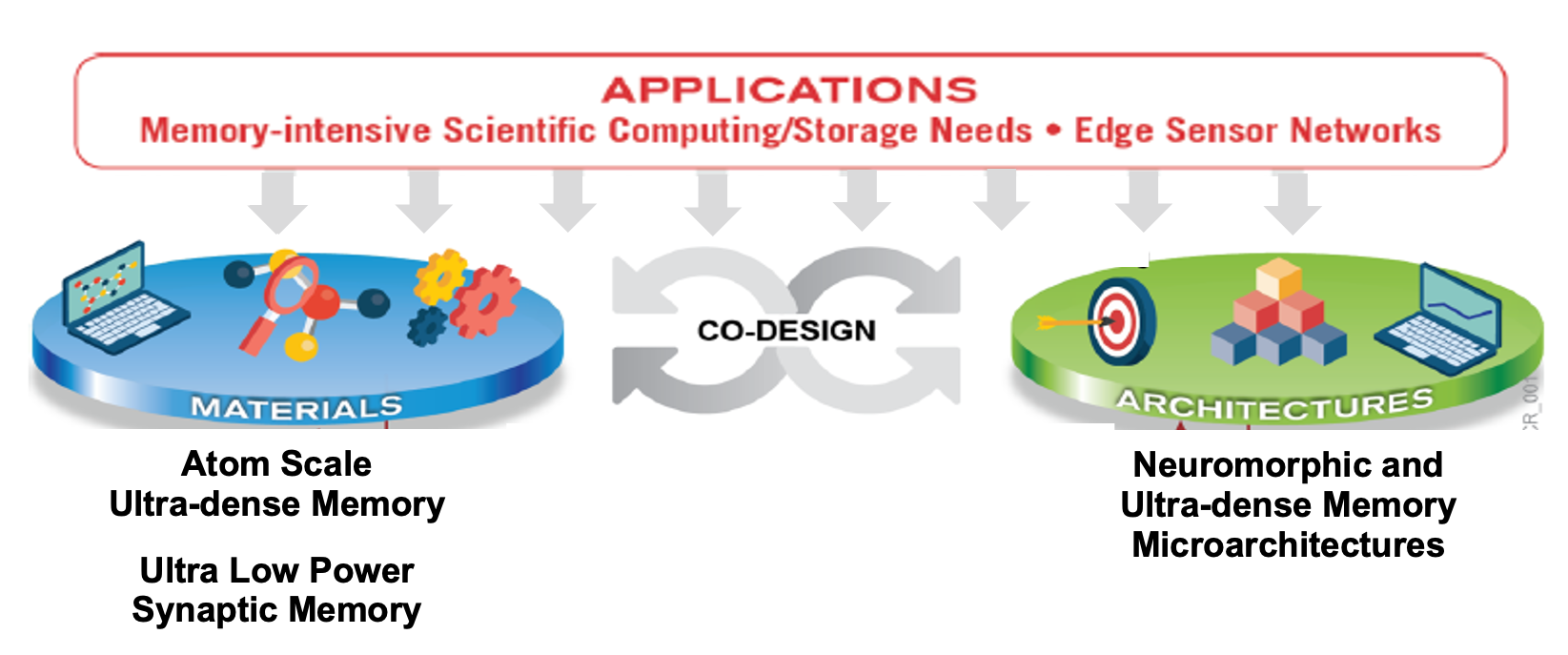Project Objectives:
Imagine a future for computing where a data-intensive sensor network becomes an intelligent distributed computer enabled by neuromorphic engines that bestow inference and training capabilities at the network edge, operate at an energy efficiency 1000X higher than is possible today, and are reconfigurable to accommodate varying workloads on the fly. Imagine memory that is as fast as flash memory (20-200 µs) but that is also as dense as DNA memory (1018 bits/cm3) and available in virtually unlimited quantities for data storage and recall for scientific applications. Imagine memory whose weights can be programmed for neuromorphic computing engines that offer smooth, drift-free analog behavior and can approach biological performance efficiencies. These are our objectives for this new research project.
The need for unlimited, fast memory and more efficient memory-centric computing looms as a critical “must have” for future global computing needs. This includes needs for scientific computing and data storage that have been well articulated at the Department of Energy (DOE): the memory needs for data storage and future high-performance computing are two examples. The materials, devices and architectures that will deliver these solutions do not exist today and need to be designed based upon a scientific understanding of mechanisms at the electronic, atomic and system level. This point has been made clear in the recent DOE Basic Research Needs Workshop through its Priority Research Directions 2 and 3.
Our goal, therefore, is to develop the scientific understanding and carry out the discovery science required to build ultra-dense, fast, DNA-class memory and synaptic memory that will be used in neuromorphic engines that can approach biological energy efficiencies for inference (applying a trained machine learning algorithm to existing data) and training (learning a new capability with existing data).
Project Challenges:
This goal is framed by three challenges. The first is the need for ultra-dense memory that enables the storage of ultra-large data sets and models. Such memory should be three-dimensional and approach DNA levels of memory density (~1018 bits/cm3) but surpass it in terms of access speeds (target of 10-100 µs). This approach pushes the computing capability enabled by memory. The second defines the need for new synaptic computing elements that can enable neuromorphic processing architectures approaching the energy efficiency and plasticity of neuron/synapse-based biological information processing. These needs far surpass today’s elementary synaptic devices that operate on the level of volts and have characteristics that limit network density and scalability. The third is: how can we design applications and computing architectures to maximally benefit from memory that is orders of magnitude more efficient and denser than is available today and delivers efficiencies in the hundreds of tera operations per second per watt (TOPS/W), approaching biological levels of efficiency? Conversely, what are the materials metrics and targets imposed by the architectural design requirements on the materials?
Approach:
Using oxide-based heterostructure materials on silicon platforms, we aim to achieve these objectives by addressing the discovery science behind the following in our research: 1) fast, optically accessed, atomic digital memory with DNA-class densities; 2) atomically engineered, ultra-low power, near-ideal synaptic memory for neuromorphic processing; and 3) learning algorithms and architectural co-design.
How can we provide specifications for, and maximally utilize the density and speed advantages from, materials systems explored in (1) and (2)? Our research aims at manipulating and understanding underlying atomic and electronic phenomena to engineer materials that can be used as the building blocks for (1) and (2). We will carry out extensive materials synthesis and in-operando experiments, and guided by theory and computation, we will develop models and estimates with the goal of accomplishing atomic-level control over the design of the materials to be able to obtain linear, analog, reversible memory response at low power. We will also establish architectural design tools, system performance tools and models that incorporate such memory for inference/training, storage applications and extreme-scale scientific computing.
